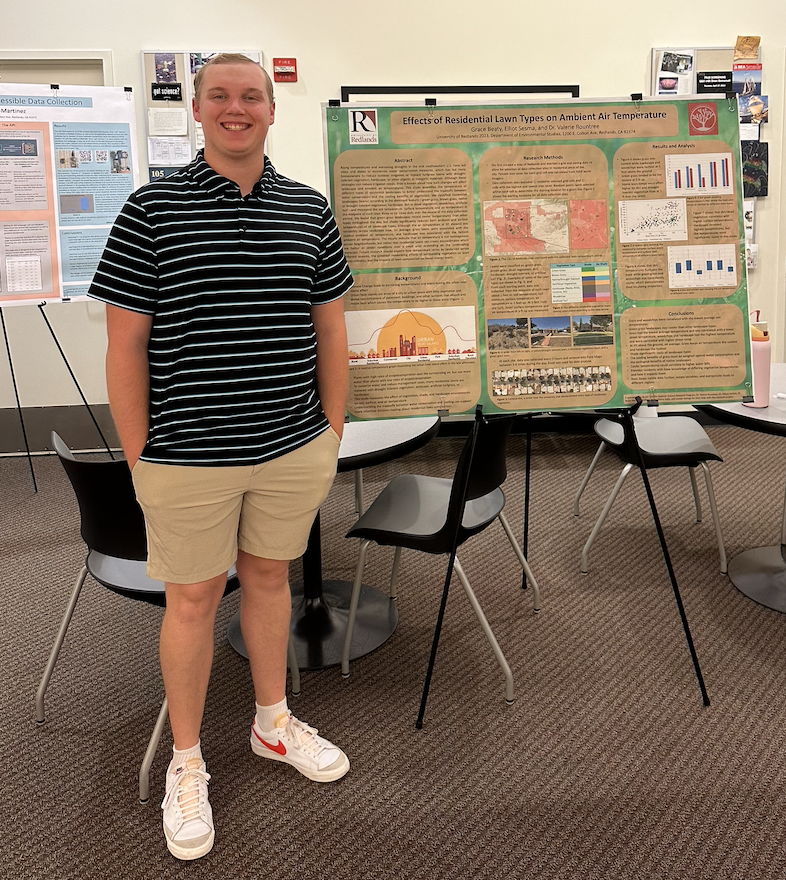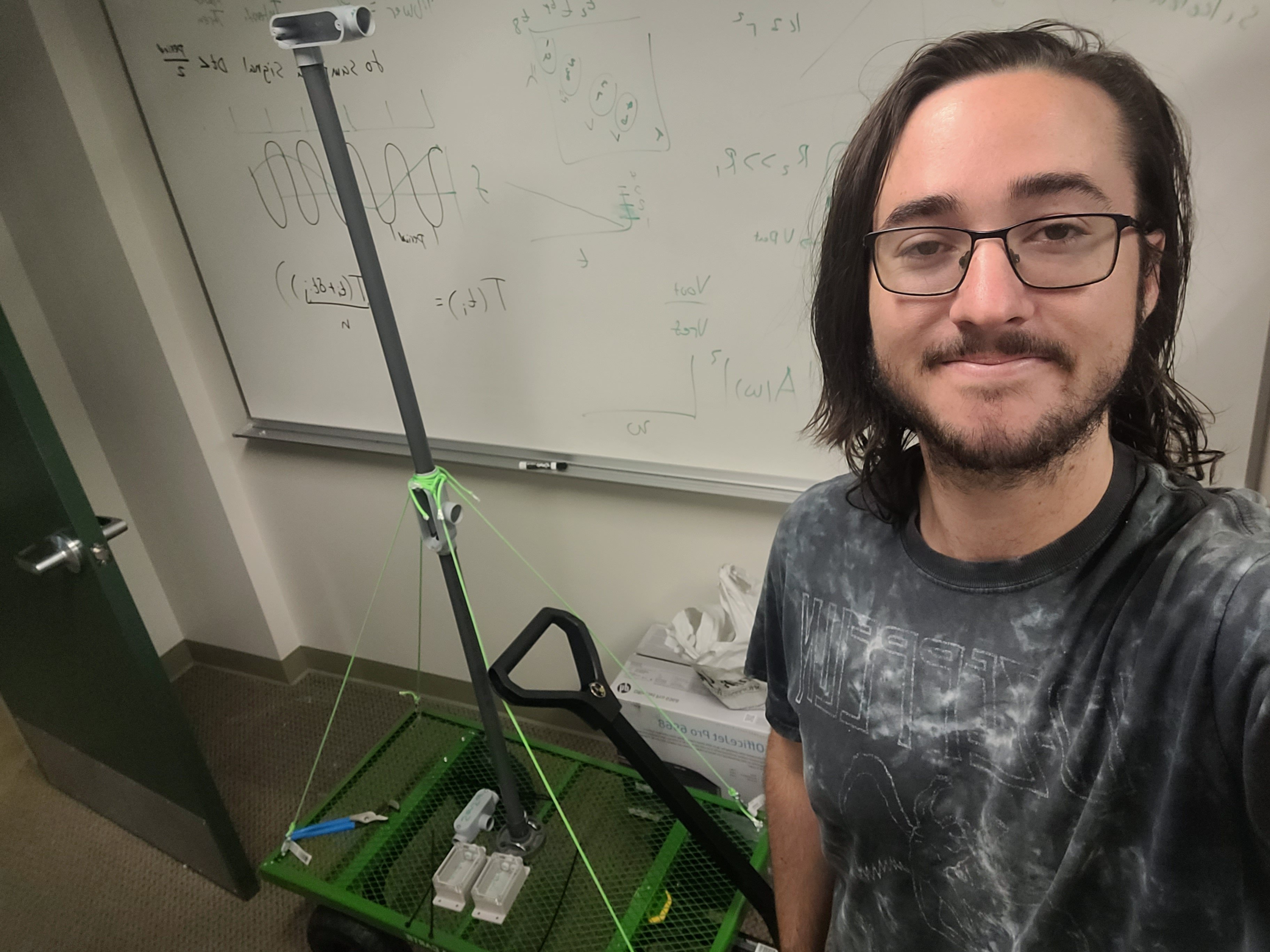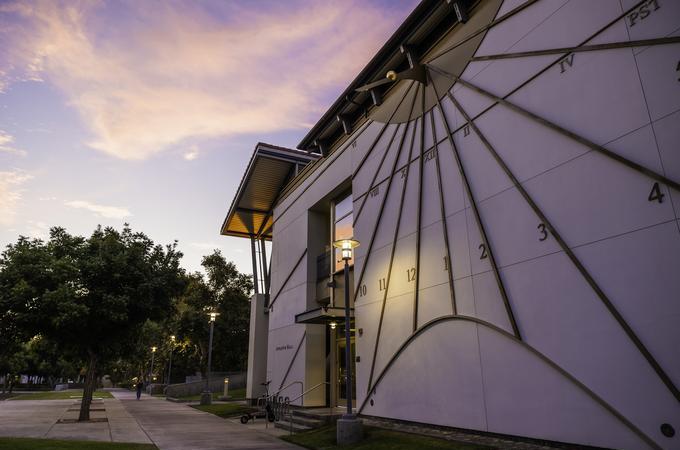Every summer, students at the University of Redlands have the opportunity to participate in the Student Science Research program, a 10-week program where students conduct research while working alongside a professor.
Elliot Sesma ’24, who is double majoring in Environmental Science and History, shares his experience while working on the Student Science Research program with the Bulldog Blog. Working with his advising professor, Valerie Rountree, Elliot conducted research on the effects of residential lawn types on ambient air temperature.
Bulldog Blog: Why did you decide to work on the Student Science Research program?
Elliot Sesma: I decided to apply for the Student Science Research program because I was looking for my first "real" job in the field I was going to be entering after graduation. I also have just recently become interested in the environmental studies area, so I wanted to get a feel for what a job might be like having this degree. Another reason was that I have had three classes with Professor Rountree, and I loved them all. Her passion for the environment became clear quickly, and it only interested me more. She is also my advisor, so having this preexisting relationship helped me know that she would be a good boss to have, and that we could work together well. On the more fun side, my roommate is also doing the program with the physics department, so I thought it would be fun to have a summer with one of my closest friends.
 BB: Can you please explain what your research is and your goals for the research?
BB: Can you please explain what your research is and your goals for the research?
ES: Professor Rountree had two main projects for our team to work on over the summer. The first one was studying the short-lived climate pollutants (CH4 and CO2 mainly) originating from California landfills and analyzing California State Senate Bill 1383, aimed at reducing these pollutants by 75% by the year 2025. The goal of that project was to determine if/how cities were in compliance with the bill and whether or not it is going to make a difference. However, that was not the main project I was on. I was studying the effects of residential lawn types on the ambient air temperature around Redlands, CA. Our main goal was to determine if different landscape types lead to the formation of urban heat islands, or if some types can help mitigate the negative impacts of one. The categories of landscape types we surveyed were green grass, brown grass, native/drought tolerant plants, hardscapes (concrete, brick, decomposed granite), dirt/dead vegetation, woodchips, and artificial turf. We wanted to see if the composition of a front yard had any impact on the surrounding temperatures, and if so, we wanted to determine how drastic the differences were.
BB: What does a typical day look like? Either in the field or on campus?
ES: A typical data collection day involves at least 3 (up to 6) collection times. The most common was taking temperature measurements at 9 a.m., noon, and 3 p.m. in order to see how the temperature fluctuates over the course of the day. We had selected our testing sites at the beginning of the project using stratified random sampling. At each site, we would try to test as many houses as we could in 75 minutes and try to hit our mark of collecting data from 3 houses of each landscape type. Whatever houses we collected from on our first visit of the day would be the houses we would come back to later. At each house we would collect the surface temperature of the yard, the temp five feet above the yard, then the surface temp of the street and five feet above the street. If permitting, we would also test the soil temperature and moisture. We inputted our data into FieldMaps by ArcGIS so each data point could be paired with a location, date, and time.
BB: What has been your favorite part of this research program?
ES: My favorite part about this program is getting to work in a smaller team of like-minded, hardworking, and creative people. My groupmates, as well as Professor Rountree, all have different skill sets and backgrounds, so having all our minds on a project made them run smoothly. I know most people would cry at the thought of having to do a 10-week-long group project, but we enjoyed every step of it. I got to make some new friends while also working alongside some old friends.
BB: How will this research help you in the future as a student or in your future career?
ES: I believe this research will help a lot more than just myself in the future. Our findings will hopefully help homeowners and landscape managers make informed decisions when addressing water scarcity and urban heat island exacerbation and help them understand the tradeoffs between the two. As a bonus, we hope it helps educate the public on sustainable landscape practices. As far as it helps me in my professional goals, I think it is very helpful that I can enter a job with actual experience in forming answerable research questions, fine-tuning research methods, analyzing collected data, and showing how that data is relevant to our ever-evolving society. I was given a great opportunity to earn experience and it paid off by helping me round out my skills as a researcher and teammate.
Keegan Moore ’25, a Physics major, shared his experience while working in the Student Science Research program with the Bulldog Blog. Working with his research advisor Physics Professor Martín Hoecker-Martinez, Keegan is investigating how different landscapes can affect temperatures and the heat island effect around campus.
Bulldog Blog: Why did you decide to work on the Student Science Research program?
Keegan Moore: I wanted to join the program because it allows me to work during the summer on the topics that I'm interested and invested in while still being an undergraduate, rather than getting a more typical summer job somewhere.
BB: Can you please explain what your research is and your goals for the research?
KM: My research involves measuring temperatures around campus to find where heat islands occur, and how the surrounding landscape and infrastructure influence this. Since man-made materials like concrete and asphalt hold on to heat much more than natural materials, it is important to consider this when building an urban area. To do that, I will be constructing and programming a cart with temperature sensors and a GPS to walk around campus with. I also collected data using six stationary sensors placed in high-traffic areas. I will then analyze the data using graphs done in Python, a computer programming language, and maps created in ArcGIS. The main goal of this project is to create a cart that will be used in Dr. Martinez's upcoming climate change class and any future projects. I am also working on a story map that will show my work in an easy-to-digest fashion, which I hope to use to encourage the University to install more trees and other heat-mitigating practices.
 BB: What does a typical day look like? Either in the field or on campus?
BB: What does a typical day look like? Either in the field or on campus?
KM: A day for me usually involves working on code or circuitry in Appleton. When I'm working with the data I collect with the stationary sensors, I'm taking the data I collected and turning it into a graph with Python. Then, I do an analysis on it, as well as inevitably having to fix my code. When I'm working on the cart, I'm using the Arduino interface to program the various sensors I have, as well as messing with the circuitry I need to connect them to the microcontroller I use. Once a day, I also must check on the sensors that are out on campus to make sure they haven't been stolen and/or collect data from them.
BB: What has been your favorite part of this research program?
KM: My favorite part of the program so far has been researching heat islands and the associated city planning that causes them, as I'm a huge nerd for all things related to urbanism and city design. It's been fulfilling to have a dedicated space to pursue that interest.
BB: How will this research help you in the future as a student or in your future career?
KM: Doing research has given me a taste for what it's like to work independently. I've only worked in food service and retail in the past, so having this kind of experience could help prepare me for the kind of work I'll be doing with my degree. Additionally, it's given me time to practice coding and working with electronics, both things that will likely be useful for me in the future.
The 2023 participants in the Student Science Research program include:
Ale Cordova, Li Almazo Garcia, Daniel Plata with Michael Ferracane (Chemistry)
Synthesis and evaluation of opioid cyclic tetrapeptides for treatment of pain and addiction.
Jordyn Caballero, Claire Love with Jim Blauth (Biology)
Monitoring wildlife and human visitation in open space reserves in Redlands using game cameras and GIS tools. Contributing to a grassland restoration experiment through soil sample analysis and native seed collection.
Ace Trede with Dustin Vanoverbeke (Biology)
Contributing to a grassland restoration project through monitoring pollinators and ground dwelling arthropods.
Madisen Hallsten with Rebecca Lyons (Chemistry)
Investigating the uptake of environmental pollutants into medicinal plants.
Lauren Kline with Bryce Ryan (Biology)
The Behavioral and Reproductive Effects of Nonylphenol in Mice: Water Consumption, Anogenital Distance, and Survival Rate.
Dan Bajda with Martin Hoecker-Martinez (Physics)
Engineering Automatic and Easily Accessible Data Collection.
Alec Kendrick with Bryce Ryan (Biology)
Identification of Sexually Dimorphic Assays in C57BL6/J Mice.
Starla Murillo, Anafer Cardenas with Sean Wilson (Pharmacology, LLU)
Para-natal lung development under low-Oxygen Conditions.
Victor Perez, Malia Miguel with Sue Blauth (Biology)
Glacturonic and Glucuronic Acid Catabolism in Sinorhizobium meliloti.
Briza Martinez with Penelope Duerksen-Hughes (Biochemistry, LLU)
30-hydroxygambogic acid (GA-OH) displays Anticancer Activity in HPV+ and HPV- Cancer Cells.
Lucy Stiff, Grace Vogt with Lei Lani Stelle (Biology)
Analyzing the Impact of Human Disturbances on Marine Mammals in Southern California.
Janet Rayo Celaya, Alejandro Palomares with Caryl Forristall (Biology)
Using Xenopus embryos to investigate hormonal pollutants.
Grace Beaty, Eli Sesma with Valerie Rountree (Environmental Studies)
Effects of Residential Lawn Types on Ambient Air Temperature.
Tyler Davies with Bryce Ryan (Biology)
The Effects of Developmental Exposure to Nonylphenol on the Nervous and Reproductive Systems of C57BL6/J Mice.
Makayla Sorenson with Julie Unternaher (Biomedical, LLU)
SNAI1 and Let-7 in Early Development and Ovarian Cancer.
Delia Carrillo with Mary Kerns-Jonkers (Biomedical, LLU)
Effects of spaceflight on heart tissue and DNA damage.
Joseph George, Celine Rafie with Valerie Rountree (Environmental Studies)
Evaluating the Implementation of SB 1383: California’s Organic Waste Diversion Policy.
Keegan Moore with Martin Hoecker-Martinez (Physics)
Investigating the Heat-Island Effect on the UoR Campus.
Student science research is funded by generous donor contributions and endowment funds. The endowments include:
Steven K. Matthias Student Summer Research Fund
Herbert W. and Kathryn E. Greydanus Endowed Fund for Student Science Research
Taylor Family Summer Science Research Endowment Fund
Hunsaker Summer Science Research Endowment Fund
Larry and Rita Seratt King Endowment for Summer Science Research
Ifft Endowed Research Fund
Steven D. and Jane R. Carmichael Student Science Research Endowment
Jerry and Arlene Lewis Endowed Fund for Student Science Research
Summer Science Research Endowment - Mrs. Julianne F. Levings
Summer Science Research Endowment - Mr. and Mrs. Jack Dangermond
Summer Science Research Endowment - Ms. Susan M. Lea
To learn more about the Student Science Research program, click this link.






